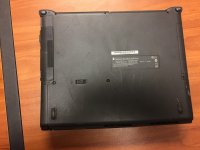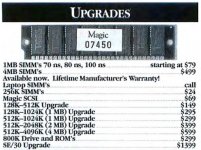.
Citation required, everything I've seen said they addressed the QC problems. I've NEVER read a credible report of problems being continuous through end of life.
Even if they did, it requires being able to certify when all of your disks and drives were made, approximately halving the available pool of usable disks and drives, or simply forgoing ever using 100MB media altogether. (A possibility, SCSI Zip250 equipment appears to have existed, with the presumption that because Zip250 was introduced in late '98 after all of this bubbled up and they fired their CEO over the quality/design problems, all Zip250 (and 750) media and drives are fine.)
And, there's a good chance they didn't, and even still,
part of the click of death problem was that old drives would fall out of alignment, and then when you put media you used in the "bad" drive into a good drive, it changes the alignment of the good drive, and the only solution is essentially to do your best to isolate the bad drive, use it to recover all the data from the disks it's touched, and then replace that drive, and I forget if you had to either replace all the disks or just reformat them with a new/good drive.
And, that's separate from issues with the media edge issues (although also caused by alignment) and (not caused by alignment IIRC) disk cover issues.
And, proportionally, Zip had these issues at a higher rate than any other type of media.
Fuggadeboudit, that's a dead horse and hindsight at its worst. Iomega won, game over.
Until they didn't. It's fairly well known as public information that Iomega was hurting in 1998, financially, because they made almost no money on the drives, which they practically gave away to a very extensive list of computer OEMs, and people didn't end up buying media at the rate Iomega had hoped.
Iomega hoped, more or less, that small internal hard disk capacities and high costs for adding new fixed disks, plus the need for transfers and backups would mean people would buy a zip drive or two and then come back for a new cartridge on the regular to do things like archive email, archive photos from scanners or digital cameras (if you really like your Mavica, you can happily run through a few diskettes worth of pictures in a week or an active day, and that can translate to a zip disk every 1-2 months, for example) and things like saving web pages, downloaded software updates, etc.
Basically, Iomega was betting on people buying Zip disks to be way worse pack-rats than they actually were.
Of course, there's also the quesiton of whether we're litigating "zip being viable or good in the '90s" or not. You're the one who keeps bringing up "back in the day" as if it has any real bearing on what we do here and now. Most of the upgrades I see people shove into their high end Macs either didn't exist or weren't practical "back in the day" -- or were themselves failed products that were never practical. *cough* Radius Rockets *cough* and yet nobody lets that change what they do today. Why does "people did it in the '90s" dictate that we should suggest people do it now?
And if you're going to say "oh, well, it was fine in the '90s" then you don't get to point to my examples from MacWorld in 1998 and say "oh, that's bad data, who cares about the '90s anyway?"
Just one year later it was celebrated by the same magazine as the 23rd best bit of tech ever?
That's a better indictment of that magazine than it is a defense of Zip as a technology. Probably different people wrote those articles and they just reflect that particular person's priorities than anything else.
Zip is still plenty good enough for transferring files across a retroMac collection. Likely the easiest to come by and by far the easiest to use if your collecting interests have you moving from machine to machine, and from storage to playpen. If your collection is small and in stasis, networking is easier, but really no more reliable for transferring files for all practical purposes. You have the benefit of setting up a variety of Zip boot disks for troubleshooting, there networking fails miserably as an all encompassing solution.
Just idly: Almost none of this is, in fact, not doable with CD-Rs. Especially if you take a good fast CD drive out of something pretty new like a Power Mac 7300/8600/9600 and put it in any ol' SCSI case. You can use the big huge keyboard command to boot basically any Mac with a SCSI port to that CD drive, including, I believe, the Plus, and then do your testing, install your software, make your backup (albeit: not to the CD drive you're booting from), or just run games and software.
For read/write needs, there's the SCSI2SD - and you can take the SD card out of that and put it in a modern computer. SD card readers cost less at your local WalMart than USB Zip drives do on eBay. Again, works on any Mac with SCSI.
Is it different from the original experience? Yes. How many people on the forum do you think care? -- The ones who do already have some kind of removable storage system-or are in the process of acquiring one-of whatever kind of media they happen to prefer. For some, it's MO because they'd rather have the reliability than some kind of "authenticity" provided by the fact that Iomega dumped Zip drives on Apple and into Wal-Mart. For some, it's Bernoulli or SyQuest because it's what they happened to have or it's because that's what was in their vintage Mac when they got it. To be honest, "it was already in the machine when I got it" or "I stumbled upon a big pile of it for cheap, at a garage sale" is probably the best reason to get Zip stuff today.
For a lot of people, the really young ones or the people who were looking in on this stuff from afar when it was new? I'm thinking most of them probably don't have any specific nostalgia one way or another. I don't think most people looked at their computer or a catalog and planned up front to need to buy a lot of extra storage for it. You ended up doing it because it turns out you like the computer a lot or because over time your needs changed or because 1.4 meg floppies ended up being a
really inefficient way to accumulate data, especially as the '90s wear on.
It's fine that you like your Zip drives. I like the Zip stuff I have too, and I'm not going to remove it from any given machine I have unless there's a
really compelling reason, but I'm also never going to advocate that someone who doesn't already have any zip stuff go get some. It's not cheap any more and there's a pretty high chance you'll come across some bad disks or drives that never got weeded out in the '90s and Zip itself is not a very resilient technology, so treating it the way you might treat floppy or LS-120 has a higher chance of breaking more things than actually being a good troubleshooting tool.
If you can accept that and you're willing to continue rebuilding your disks and backups and take the risk of losing data and losing equipment, then Zip is fine, but why pay for something twice when you can get something that you can be sure you'll only have to pay for once? Why pay for the thing at all if you can have a similar or better experience with a modern technology that performs better and is less likely to have problems?
I'm not out to tell you to dump all your zip stuff. I'm out to make the point that we as a community should be more careful about what we recommend to people who don't know better. If people are going to engage in complaining
bitterly about RAM ceilings on LC-family computers, or the board design of the LC 6200, then I think we get to allow discussion about the fact that Zip proved itself while it was in production to be the least reliable magnetic media storage format, and this was discussed openly in the Mac tech press at the time. Just as the weird RAM limit on the Macs LC & TV, the bad hinges on the PowerBook 5x0, and the bad keyboards on the newest MacBook Pros all have been.
(Worth noting: MacWorld is also pretty open about Jaz and contemporary SyQuest media being pretty bad on the reliability front, and also Castlewood Orb was pretty bad. Syquest's newer stuff, SyJet and Sparq, and the anticipated 4.7-gig cartridge format were all so bad that Syquest
did actually go bankrupt, and Iomega bought them, probably to get at IP and patents.)



